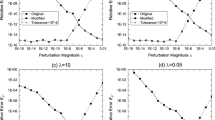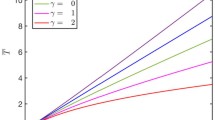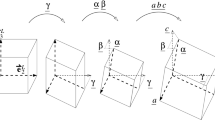Abstract
The invariants in the K-BKZ constitutive equation for an incompressible viscoelastic fluid are usually taken to be the trace of the Finger strain tensor and its inverse. The basis for this choice of invariants is not derived from the K-BKZ theory, but rather is due to the perception that this is the most natural choice. Research into using other sets of invariants in the K-BKZ equation, such as the principal stretches or the eigenvalues of the Finger strain tensor (i.e., the squares of the principal stretches) is relatively new. We attempt here to derive a K-BKZ equation based on the squares of the principal stretches that models the behavior of a low-density polyethylene melt in simple shear and uniaxial elongational deformation. In doing so, two assumptions are made as to the form of the strain-dependent energy function: first, that there is a function f(q) such that the energy function can be written as the sum of f(q i ),i = 1, 2, 3, where the q i 'sare the squares of the principal stretches, and second that f is a power law. We find that the K-BKZ equation resulting from these two assumptions is inadequate to describe both the shear and elongational behavior of our material and we conclude that the second of the above assumptions is not valid. Further investigation, including predictions of the second normal stress difference and some finite element calculations reveals that the first assumption is also invalid for our material.
Similar content being viewed by others
References
Bernstein B, Kadivar MK, Malkus DS (1981) Steady flow of memory fluids with finite elements: two test problems. Comput Meth Appl Mech Engng 27:279–302
Bernstein B, Kearsley EA, Zapas LJ (1963) A study of stress relaxation with finite strain. Trans Soc Rheol 7:391–410
Bernstein B, Feigl KA, Olsen ET (submitted for publication 1993) Steady flows of viscoelastic fluids in axisymmetric abrupt contraction geometry: a comparison of numerical results. J Rheol
Bernstein B, Malkus DS, Olsen ET (1985) A finite element for incompressible plane flows of fluids with memory. Int J Number Meth Fluids 5:43–70
Delves LM, Mohamed JL (1985) Computational methods for integral equations. Cambridge University Press, Cambridge
Kaye A (1962) College of Aeronautics, Cranford, UK, Note no 134
Kaye A (1992) A constitutive equation for a non-Newtonian liquid. Rheol Acta 31:3–13
Knobel B (1991) Untersuchung der Einlaufströmung einer Polyäthylen-Schmelze in eine Düse von kreisförmigem Querschnitt mit der Laser-Doppler Anemometrie. Ph D Thesis, Diss ETH Nr 9480
Leblans P (1987) Nonlinear viscoelasticity of polymer melts in different types of flow. Rheol Acta 26:135–143
Meissner J (1972) Development of a universal extensional rheometer for the uniaxial extension of polymer melts. Trans Soc Rheol 16:405–420
Meissner J (1985) Rheometry of polymer melts. Ann Rev Fluid Mech 17:45–64
Meissner J, Garbella W, Hostettler J (1989) Measuring normal stress differences in polymer melt shear flow. J Rheol 33:843–864
Meissner J, Raible T, Stephenson SE (1981) Rotary clamp in uniaxial and biaxial extensional rheometry of polymer melts. J Rheol 25:1–28
Ogden RW (1984) Non-linear elastic deformations. Ellis Horwood Limited, Chichester
Ramachandran S, Gao HW, Christiansen EB (1985) Dependence of viscoelastic flow functions on molecular structure for linear and branched polymers. Macromolecules 18:695–699
Valanis KC, Landel RF (1967) The strain-energy function of a hyperelastic material in terms of the extension ratios. J Appl Phys 38:2997–3002
Venerus DC, Bernstein B (1992) Utilization of stress growth experiments to determine strain-dependent material functions. In: Moldenaers P, Keunings R (eds) Theoretical and applied rheology. Elsevier Science Publishers BV, Amsterdam
Wagner MH, Demarmels A (1990) A constitutive analysis of extensional flows of polyisobutylene. J Rheol 34:943–958
Wagner MH, Stephenson SE (1979) The irreversibility assumption of network disentanglement in flowing polymer melts and its effects on elastic recoil predictions. J Rheol 23(4):489–504
Author information
Authors and Affiliations
Rights and permissions
About this article
Cite this article
Feigl, K., Öttinger, H.C. & Meissner, J. A failure of a class of K-BKZ equations based on principal stretches. Rheol Acta 32, 438–446 (1993). https://doi.org/10.1007/BF00396174
Received:
Issue Date:
DOI: https://doi.org/10.1007/BF00396174




